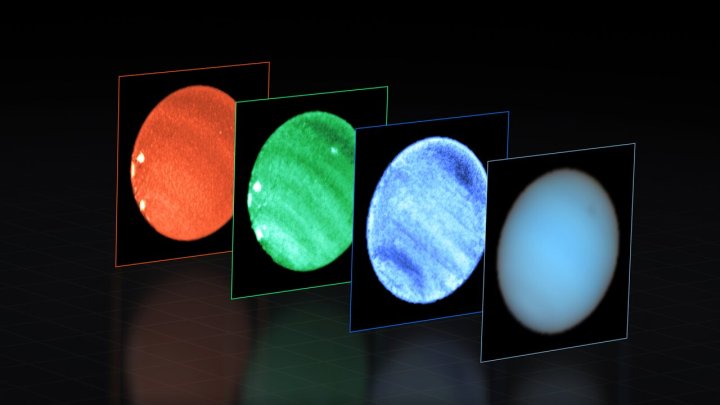
Whereas primarily the most eminent planetary enviornment within the solar system would desire to be Jupiter’s Immense Red Place, an chronicle storm 10,000 miles wide that has been raging for a whole lot of years, other planets are identified to host spots of their possess as nicely. That entails Neptune, which had a monumental darkish enviornment that change into once first imaged by Voyager 2 when it passed by within the Eighties.
Neptune’s enviornment change into once named the Immense Dark Place, however when the Hubble Dwelling Telescope tried to image the enviornment in 1994, it had disappeared. Now, a Neptune enviornment has been imaged from the bottom for the first time, the usage of the European Southern Observatory’s Very Wide Telescope (VLT).

“Since the first discovery of a unhappy enviornment, I’ve consistently puzzled what these short-lived and elusive darkish parts are,” said lead researcher Patrick Irwin of the College of Oxford in a assertion.
Hubble returned to stride wanting Neptune and observed one other enviornment within the northern hemisphere in 2018, providing the probability for astronomers to scrutinize a enviornment whereas it change into once demonstrate. They extinct an instrument on the VLT called MUSE, or the Multi Unit Spectroscopic Explorer, to salvage spectrographic records which reveals a 3D peek of the enviornment by wanting at varied ranges within the atmosphere. The learn means that the enviornment is ended in by darker air particles, which procure beneath the hazy layer within the planet’s atmosphere.
“I’m fully extremely elated to had been able to now not most spicy assemble the first detection of a unhappy enviornment from the bottom however moreover sage for the very first time a reflection spectrum of such a characteristic,” said Irwin.

The researchers moreover found an unexpected sparkling enviornment next to the darkish enviornment, belief to be an odd blueprint of cloud. The learn reveals how astronomers can learn extra about the atmospheres of distant solar system planets from the bottom.
“That is an extra special enhance in humanity’s capacity to stride wanting the cosmos. First and significant, shall we most spicy detect these spots by sending a spacecraft there, love Voyager. Then we won the power to assemble them out remotely with Hubble. Sooner or later, skills has stepped forward to enable this from the bottom,” said co-creator Michael Wong.
The learn is published within the journal Nature Astronomy.
Editors’ Suggestions
-
James Webb spots feeble mud that might possibly presumably be from the earliest supernovas
-
One galaxy, two views: peek a comparability of pictures from Hubble and Webb
-
James Webb investigates thriller of where Earth’s water comes from
-
JUICE mission to Jupiter sends reduction first pictures of Earth from space
-
Scientists look the aftermath of a spacecraft crashing into asteroid

Georgina is the Digital Traits space creator, covering human space exploration, planetary science, and cosmology. She…
James Webb spots exoplanet with gritty clouds of sand floating in its atmosphere

One in every of primarily the most delightful things about the James Webb Dwelling Telescope is that now not most spicy can it detect exoplanets, however it completely also can explore into their atmospheres to acknowledge what they are unexcited of. Figuring out exoplanet atmospheres will reduction us to search out doubtlessly habitable worlds, however this can moreover turn up some difficult oddities — love a most unique finding of an exoplanet with an environment plump of gritty, sand clouds.
Exoplanet VHS 1256 b, around 40 light-years away, has a posh and dynamic atmosphere that reveals mighty adjustments over a 22-hour day. Now now not most spicy does the atmosphere demonstrate evidence of regularly observed chemicals love water, methane, and carbon monoxide, however it completely moreover appears to be dotted with clouds made up of silicate grains.
Read extra
Astronomers half early pictures from James Webb’s galaxy scrutinize

One in every of the significant goals of the James Webb Dwelling Telescope is to stride wanting about a of the earliest galaxies within the universe, and to enact that it needs with the arrangement to acknowledge extraordinarily distant objects. However wanting at a explicit very extinct galaxy in detail is most spicy half of of the bother. To primarily realize the earliest phases of the universe, astronomers moreover desire to acknowledge how these very extinct galaxies are distributed so that they can realize the monumental-scale constructing of the universe.
That is the arrangement of the COSMOS-Web program, which is the usage of James Webb to scrutinize a huge space of the sky and see these uncommon, feeble galaxies. It goals to scrutinize as a lot as 1 million galaxies someday of over 255 hours of looking out at time, the usage of both Webb’s terminate to-infrared digicam (NIRCam) and its mid-infrared instrument (MIRI) digicam. Whereas there is unexcited a range of looking out at left to enact, the researchers within the COSMOS-Web program fair now not too long within the past shared about a of their first outcomes.
Read extra
The ghostly remnants of a unnecessary considerable person captured in sparkling image

When a huge considerable person runs out of gas and springs to the cease of its lifestyles, it could possibly possibly presumably explode in an monumental and chronicle occasion called a supernova, that might possibly presumably moreover be as sparkling as a whole galaxy. These explosions can obliterate one thing else around them, however they’re now not merely adversarial — they can moreover produce sparkling buildings called supernova remnants. These remnants are fashioned as shock waves from the explosion scramble via nearby clouds of gas, sculpting them into comely shapes.
One such ghostly remnant has been captured by a floor-primarily based completely mostly instrument called OmegaCAM on the European Southern Observatory’s VLT Undercover agent Telescope. The Vela supernova remnant is found 800 light-years away and change into once created by the loss of life of a considerable person around 11,000 years within the past.
Read extra